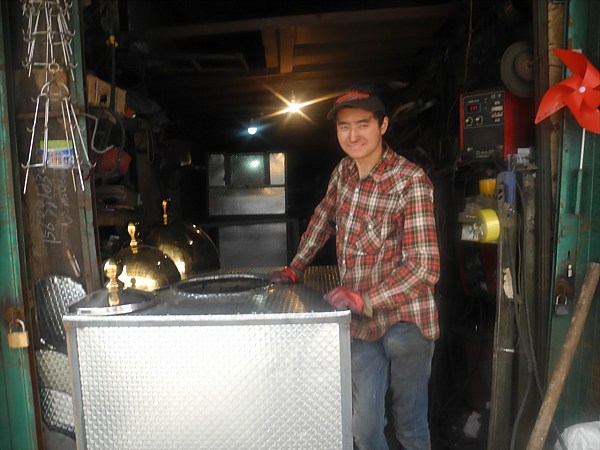How Uighur flat bread ovens are made in Urumqi.
 Published on June 26, 2015
Follow me on Twitter here.
Published on June 26, 2015
Follow me on Twitter here.
The factory spilled out into the street. It wasn’t very big, being just a single story that stretched on for three shops at the edge of the Grand Bazaar in Urumqi. There were piles of steel planks and half assembled globular welded contraptions tumbling out from the factory’s open doors. Standing next to one of these waist high steel spheres was a young guy caked in factory grime. He had a dirty job but he was smiling.

I smiled back as I crossed the clutter strewn market street and asked him what he was making.
“Nangang,” he said.
An oven for making the traditional style flat bread that Muslims and Islam influenced cultures make all over the world.
These ovens have simply, difficult to improve upon, timeless design. They consist of an inner spherical piece that is open at the top which is placed inside of an outer, rectangular shell. Between these two pieces is a space to allow for the circulation of the hot air that is heated from below by wood, coal, or gas. The dough, which is patted down into patties, is stuck along the walls of the inner sphere where it’s baked into bread.
The ovens that this factory was kicking out were impressive and seemed to be rather high end. They were primarily being made with two types of metal. The inner spheres were made from ridged steel, like the kind used to make running boards for trucks, non-slip ramps, and industrial flooring and stairs. While the outer shell was constructed from sheet metal. When finished, these apparatuses would stand around belly button height up from the ground.

I watched as a crew of around a dozen guys pounded, bent, and welded the pieces of metal in place. The inside of the factory was dark, the sparks from welders could be seen reflecting off the walls. There were pieces of half finished ovens and piles of steel everywhere. The workers moved nimbly through the clutter, moving from half-finished oven to half-finished oven.
Once assembled, the outsides of the ovens would receive some styling and they would be sold to local restaurants or street vendors for the equivalent of around two hundred dollars.
As I travel I find myself draw to scenes like this. Travel writing is one part story telling, one part reporting, and one part documentation. The documentation part is what I often find the most intriguing, as it’s simply the recording of what particular people do, think, and use in a particular place at a particular time. It’s the story of everyday life, everywhere.

Looking at places like this flat bread oven factory is like preemptively viewing a type of living time capsule. You can never tell how long these manufacturing methods will last or when they will disappear — when the people find other faster, cheaper, or easier ways of doing something and move on. So when I see a bunch of grime encrusted men toiling over hunks of metal, assembling goods by hand in street-side factories I stop to take a long look. I know that the next time I walk down this street they may not be there.





About the Author: VBJ
I am the founder and editor of Vagabond Journey. I’ve been traveling the world since 1999, through 91 countries. I am the author of the book, Ghost Cities of China and have written for The Guardian, Forbes, Bloomberg, The Diplomat, the South China Morning Post, and other publications. VBJ has written 3705 posts on Vagabond Journey. Contact the author.
VBJ is currently in: New York City
Next post: View From My Window: Horgos, Xinjiang
Previous post: Uighur Ice Cream

